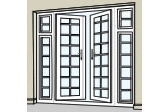
Popular for their ability to ‘open up’ a space and create a big entry or exit, french doors vary significantly both in their size, and in the materials they’re constructed from.

What is a French door?
A French door is a hinged door, usually found in pairs, that consists of light wooden joinery framing large panels of glass or other transparent material. This allows plenty of light into a room, and provides a nice, unobstructed view outside. These doors can be found all over the streets of Paris and Rome, usually leading out to a balcony or terrazzo. They are also referred to as French windows, due to the fact that they look and act much like a standard window.
How do French doors work?
French doors work in the same way as other hinged doors. These doors are typically outside facing, so will generally swing inwards. Double French doors are normally locked by bolting the upper and lower parts of each door, as well as using a conventional lever or knob handle lock or deadbolt.
Where are French doors used?
French doors are found both inside homes and as exterior doors, but are most commonly used to allow access to a small garden, porch or balcony. French doors are often be used as a substitute for windows, because they let plenty of light in and they don’t obstruct the view in the way that solid doors might.
Doors facing outside are best equipped with weather strips to prevent wind and rain from getting into the building. Likewise, double glazing or low-e glass can make a significant difference to the amount of heat that’s allowed in or out of the home, just as it does with conventional windows.
Because of their lightweight construction and materials, French doors made of everyday glass generally don’t provide enough security to be used as main entrance doors. For this purpose, things like toughened glass, Plexiglas or Lexan offer better protection.
What variations are there in French doors?
Points of variation between French doors include the type of wood and detail used for the joinery, whether glass or another transparent material is used for the panels, and whether or not the joinery has been painted or left natural. The most common (and most ‘traditional’) colour for the joinery is white, though this depends entirely on surrounding décor.
|
Advantages
|
Disadvantages
|





